Excerpts from Jim Conrad's
Naturalist Newsletter
Entry dated February 18, 2024, issued from near Tequisquiapan; elevation about 1,900m, (6200 ft), ~N20.57°, ~W99.89°; Querétaro state, MÉXICO
MONTANOA TOMENTOSA

On the edge of a small village, enmeshed in a 5m (16ft) tall hedge of spiny Desert Hackberry, Smooth Mesquite and weeds, the above semiwoody shrub's slender stems up to 2.5m tall (8ft) snaked through the brush. The stem-tip, branching, panicle-type inflorescence was composed mostly of almost mature fruiting heads; only the head appearing below still bore flowers.
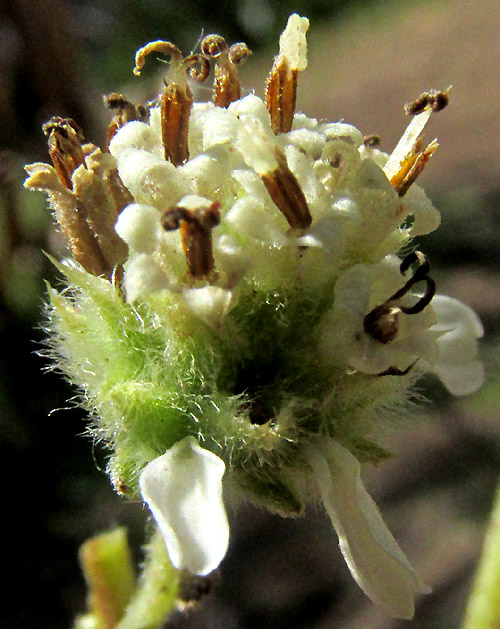
With numerous florets packed into a head subtended by a green, scaly involucre, the bush is a member of the largest of plant families, the Composite/Aster/Sunflower Family, the Asteraceae. In that family, enormous diversity of flower structure and function is expected. However, when taking the above picture I never suspected that, because of a feature right there in front of us, it would end up the subject of intense speculation.
That's because the above flowering head is composed of two distinct floret types: disc florets in the center with corollas consisting of cylindrical tubes topped by five recurving lobes, and ray florets along the cluster's periphery with corollas consisting of flat ligules. The genus to which this plant belongs is not supposed to produce ray florets at all.
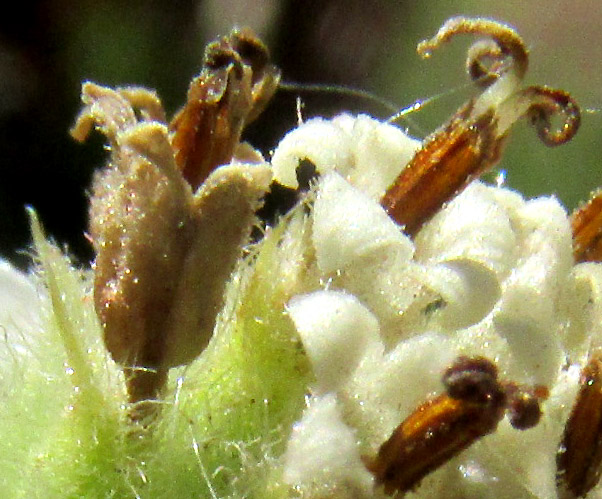
The above image also is jarring in that it doesn't show "normal Aster Family structure." At the left, the older, dried-brown disc floret arises from a somewhat scoop-shaped, green item which typically would be interpreted as one of the subtending involucre's scale-like phyllaries. However, on the right side of that floret we see the unopened, dome-shaped top of an unexpanded corolla of a second disc floret, whose base also is enveloped by a green item. And behind that unopened corolla, barely visible below downcurving corolla lobes, there's yet another green, pointed tip. Eventually it was realized that in this cluster of flowers each single floret was subtended by its own much-simplified involucre. The whole head comprised numerous such one-floret-bearing involucres.
Here we're seeing "secondarily aggregated flowering heads." Of the 1688 genera which as of January 2023 are accepted by the Plants of the World Online database as constituting the Aster Family, few develop such structures. This distinction of our bush enables us to be more certain of our plant's genus, and when we look up that genus, we're told its species aren't supposed to bear ray florets.
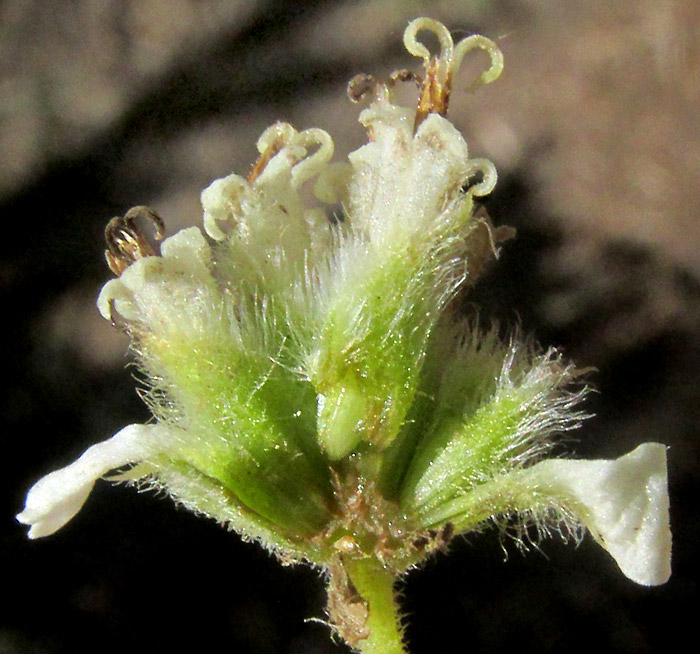
The above flowering cluster is broken open better to show that each floret has its own simplified -- but very hairy -- involucre. On each side of the cluster, at its base, there's a single ray floret. The ray florets are sterile, producing no fruits, so their involucres are much slenderer than the disc florets'.
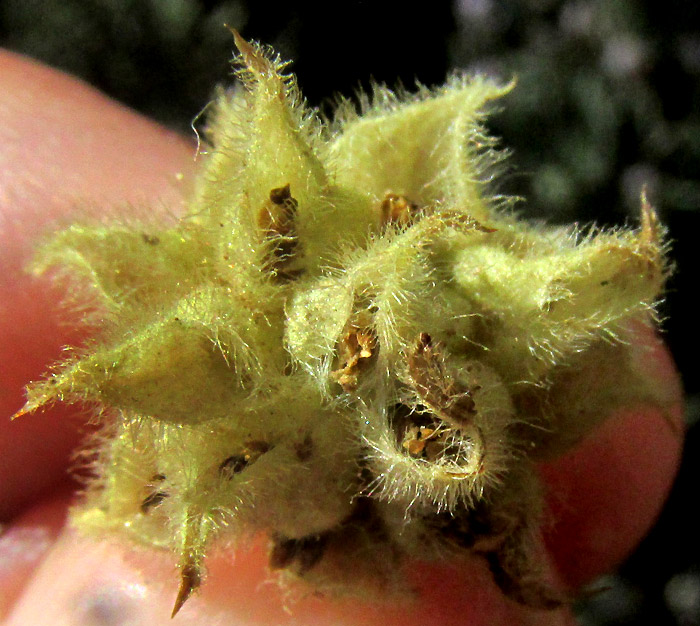
Above, several much-simplified involucres bear inside dried-up and brown disc florets.
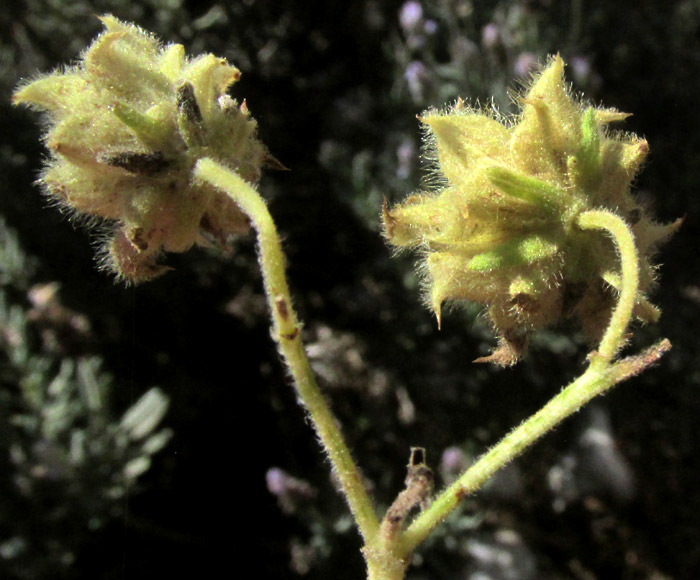
Above, two secondary heads each are subtended by modified leaves looking like involucral bracts, or phyllaries, below more typical flowering heads.

Simple leaves appear in pairs opposite one another on stems, and their margins are irregularly low-toothed or lobed. The upper blade surface is somewhat whitish with short hairs lying close to the blade's surface.

The blades' undersurfaces are densely soft-hairy. In the image it's hard to say whether the blade surface and hairs are glandular, but it seems that they could be.
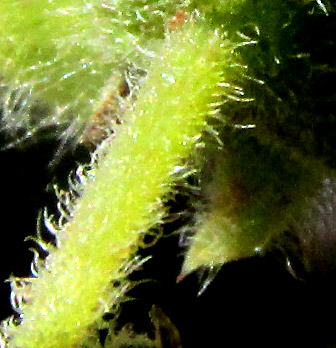
At the right, some of the petiole's hairs could be tipped with small glands, but that's unclear.
I had problems identifying this species. When the above pictures were uploaded to iNaturalist, user "oscargsol," an expert on Mexican members of the Aster Family, recognized it as MONTANOA TOMENTOSA, with no English name.
Montanoa tomentosa occurs fairly commonly, mostly in disturbed upland habitats such as our roadside, throughout most of upland Mexico, south into Costa Rica. The 1982 study by V.A. Funk entitled "The Systematics of Montanoa (Asteraceae, Heliantheae)," may explain one reason for my problems in identifying it. Funk described two major problems affecting identification of Montanoa species: "extensive morphological variation and widespread parallel evolution." Parallel evolution is when different, not closely related species evolve similar features in response to similar evolutionary pressures.
Montanoa tomentosa is an important plant in traditional Mexican medicine, mainly to help and accelerate the process of childbirth.